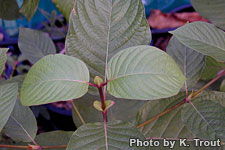Kratom
Basics
DESCRIPTION #
Kratom (Mitragyna speciosa) is a tropical tree growing from 15-50 feet tall (5-15 meters) that is native to Thailand and Malaysia. It has broad, oval leaves that taper to points, yellow flowers that grow in clusters, and winged seeds. The primary active chemicals are mitragynine, mitraphylline, and 7-hydroxymitragynine, all found in the leaves. Kratom leaves have been chewed for stimulant, sedative, and euphoric effects by people in Thailand and South Asia for centuries. They can also be smoked, brewed as a tea, or made into an extract. Kratom use is relatively uncommon in the US and Europe, though it is available in raw and extract-enhanced forms from ethnobotanical vendors.
Kratom leaves differ greatly in potency, depending on the type, grade, and freshness. Leaves with green veins are often claimed to be more potent than those with red veins, but there is contradictory evidence. Low doses are around 2-4 g of plain dried leaf, moderate doses are 3-6 g, and strong doses are 5 g or more. When chewed fresh, half of a large leaf (8-10") is often enough to produce noticeable effects.
Price #
Dried, untreated leaves are available from ethnobotanical vendors for 30-80 cents (USD)/gram. Higher potency extracts may cost $2-8 USD/gram. (2009 data)
Kratom is currently uncontrolled in the United States. In 1946 it was made illegal to buy, sell, or grow in Thailand, and in 2005, both M. speciosa and mitragynine were made illegal to buy, sell or possess without a license in Australia.
Kratom leaves contain the indole alkaloids mitragynine, mitraphylline, 7-hydroxymitragynine, and numerous other alkaloids, including paynanthine, speciogynine, and speciofoline. Mitragynine has traditionally been cited as the primary active chemical in kratom leaves, but some recent evidence points to 7-hydroxymitragynine instead.
Pharmacology #
Mitragynine is a partial agonist of the mu- and delta-opioid receptors. This may account for its apparent efficacy in treating opiate withdrawal (see Babu et al. 2008). Because kratom acts as both a stimulant and a sedative, secondary alkaloids may be pharmacologically important.
Production #
Kratom grows wild in marshy regions in Asia and the Pacific Rim, especially Thailand, Malaysia, Borneo, and New Guinea.
History #
Kratom appears to have been used in Thailand for centuries, recreationally and as an antidiarrheal. Its use as an opiate substitute in Malaysia was reported in the nineteenth century. Peasants have used it to counteract the tedium of physical labor, similar to the use of coca in South America. The chemistry of its alkaloids was investigated in the 1920s, and mitragynine was isolated in 1923. Kratom leaves became part of the ethnobotanical trade in the United States and Europe in mid 2000. In the early 2000s, stories about the use of kratom to reduce opiod withdrawal effects began circulating on web forums.
Terminology / Slang #
The Substance:
Kratom; Mitragyna speciosa; Ketum; Kakuam; Ithang; Thom.
The Experience:
No common terms known.
EFFECTS #
Kratom is often described as producing simultaneous, contradictory effects. Users report both an opiate-like sedation and coca-like stimulation. The stimulating effects tend to predominate at low dose levels, which may cause alertness, energy, and mild euphoria. Higher doses tend to be more tranquilizing, causing an opiate-like dreamy reverie. Excessive doses can cause severe nausea. Kratom is sometimes used as an opium substitute and has been found to suppress symptoms of opiate withdrawal. As with opium, it is known for causing constipation, and is sometimes used as a treatment for diarrhea.
Onset #
When taken orally, kratom effects typically become noticeable in 15-20 minutes and clearly apparent in 30-60 minutes. Strong doses may have a more rapid and dramatic onset.
Duration #
A moderate kratom dose can cause strong effects lasting 2-4 hours, though residual effects can last hours longer. Users sometimes experience an afterglow the next day.
Visual Effects #
Some visual effects are reported, including both open-eye and closed-eye effects, though they are considered fairly mild if they occur at all. Effects reported include wavering, shifting, and strobing in the visual field; some patterning with eyes closed; and increased closed-eye visualizations.
PROBLEMS #
Kratom is not known to be toxic, but it can be quite unpleasant at high doses, causing nausea and vomiting. Regular use can lead to physical dependency. Kratom use can cause constipation similar to that caused by opiates. Chronic heavy use is reported to cause darkening of skin, insomnia, dry mouth, and anorexia.
Contraindications #
- Do not operate heavy machinery. Do not drive.
- Care should be taken if combining with other sedatives (or stimulants).
- Use extreme caution if combining with MAO inhibitors. Kratom could be dangerous to combine with an MAOI.
Addiction Potential #
There are reports of physical dependency after frequent, heavy kratom use. Individuals who use it regularly or in large doses may find it difficult to stop. Withdrawal symptoms include irritability, yawning, diarrhea, runny nose, and pain in the joints or muscles.
Long Term Health Problems #
Long Term Health Problems Summary Needed.
Risk of Death #
There is one case in the medical literature in which kratom is believed to have contributed to the death of a 17-year-old male. Because he was alone, the exact cause of death could not be fully verified, however the medical examiner certified the cause of death as "possible Kratom toxicity". (Neerman et al. 2012) Animal studies have found even very large doses of mitragynine (920 mg/kg) to be non-lethal.
CAUTION & DISCLAIMER #
Erowid Basics pages are summaries of data gathered from site visitors, government documents, books, websites, and other resources. We do our best to keep this information correct and up-to-date, but the field is complex and constantly changing. Information should always be verified through multiple sources.


